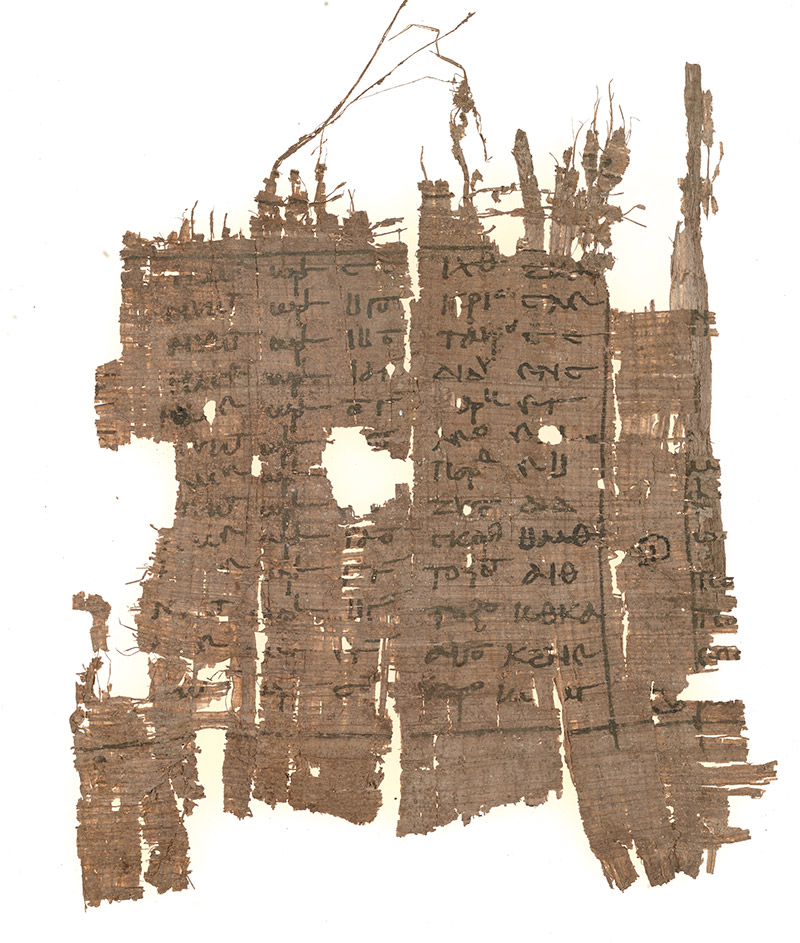Moon Phases and Calendars

- Fragmentary list of Full Moons, giving hours and longitudes.
- Mich. III 150 = P. Mich. inv. 3823, University of Michigan Library, Papyrology Collection.

- Fragmentary list of Full Moons, giving hours and longitudes.
- Mich. III 150 = P. Mich. inv. 3823, University of Michigan Library, Papyrology Collection, lines 3-5 in boxes “hour 12 0” (line 3) and “hour 0 1/3” (line 5).
The papyrus, which may date to the third century CE, contains a fragmentary list of Full Moons, giving hours (of day or night) and longitudes for 13 consecutive oppositions during one year.
The phases of the Moon were extensively studied in antiquity as many calendars, especially in Greece, were based on lunar phases. The Moon orbits around the Earth in a little more than 27 days and we see it illuminated differently according to its elongation from the Sun. In particular, we have a Full Moon when the Moon is in opposition to the Sun, though if the Moon is close to the plane of the Earth’s orbit the illumination may be partly or totally cut off for a few hours, causing an eclipse.
Full Moons happen once every synodic month, which is on average ca. 29.53-days long. The synodic month is longer than the Moon’s orbit around the Earth because the Moon has to go around the Earth once and then catch up to the Sun which has moved about 27 degrees in those 27 days. It takes a little more than 2 days for the Moon to move those additional degrees and finally catch up with the Sun.
Calendars built using synodic months are lunar calendars and they can have months of 29 or 30 days. However, for daily life and especially for farming activities, which depend on seasons, a calendar also needs to take into account the Sun’s position with respect to the Earth, since this is what determines the seasons on earth. The Greeks, like many ancient cultures, therefore also used luni-solar calendars. In these calendars, in order to make the seasons work properly, they sometimes had years with 13 months (12 standard months + an intercalary month), so as to bring the months back in line with the correct seasons.
In Egypt, the civil calendar was not lunar, but had years of 12 months, each of 30 days, to which 5 additional days were added at the end; however, some religious festivals were tied to particular phases of the Moon, and conjunctions and oppositions of the Sun and Moon were considered astrologically significant. Until Egypt became a Roman province in 30 BCE, there were no leap years in the Egyptian calendar, so that months did not align in the same way with the seasons after a certain amount of time. Beginning with 22/23 BCE, Augustus introduced a sixth additional day at the end of every fourth year to fix the seasonal alignment; this reformed calendar is sometimes called the Alexandrian Calendar. Astronomers and astrologers such as Ptolemy continued to use the old Egyptian calendar for the sake of astronomical calculations; however, this papyrus gave dates in the Alexandrian calendar.
The papyrus tabulates a calendar year that contained 13 Full Moons. The table gives seasonal hours of day or night (that is, twelfths of the interval from sunrise to sunset or sunset to sunrise; hence seasonal hours had different durations during the year) and ecliptic longitudes of the Full Moon in degrees and minutes within each sign, expressed as simple sexagesimal numbers without specifying that they represent degrees. The longitudes were not observed but computed, using arithmetical constants typical of Babylonian astronomy. Seasonal hours are expressed using fractions in multiples of 1/3 hour. When the hour is a whole number, the whole number is followed by the zero symbol of the Greek sexagesimal notation; the zero symbol is also used when there are only fractions of hour, e.g. “hour 0 1/3” (indeed, the Greeks did have a zero!—and they had a specific symbol for it,  ; see detail).
; see detail).
The rightmost column belongs to a similar table probably belonging to a later year, giving the Egyptian months of that year's oppositions (or perhaps its conjunctions).
Both the longitudes of the Full Moon and the times of the moment of opposition vary from year to year, so that can help us to determine when those listed in the papyrus took place. Yet establishing the correct years for the tables is an unsolved problem; Alexander Jones, who is currently studying the papyrus, suggests, as a possibility, 334/335 CE.
There are other tables of computed oppositions or conjunctions, including P.Oxy. astr. 4214, P.Colker and P.Cair. Mus. S. R. 3059 (part), all studied by Alexander Jones.
Select Bibliography
- Delporte, E. 1947. “Papyrus Michigan III.” Chronique d’Egypte 22 (43): 73-83.
- Jones, Alexander. 2016. “More Babylonian Lunar Theory in the Astronomical Papyrus P.Colker.” Zeitschrift für Papyrologie und Epigraphik 199: 137-143.
- Neugebauer, Otto. 1942. “On Some Astronomical Papyri and Related Problems of Ancient Geography.” Transactions of the American Philosophical Society 32 (2): 251-263, at 251-252.
- Neugebauer, Otto. 1975. A History of Ancient Mathematical Astronomy. Studies in the History of Mathematics and Physical Sciences. 1. New York: Springer-Verlag: 170–183.
- Robbins, Frank E. in Winter, John Garrett. 1936. Papyri in the University of Michigan Collection III: Miscellaneous Papyri University of Michigan Studies: Humanistic Series. Ann Arbor: University of Michigan Press: 117-118 [P. Mich. III 150].

